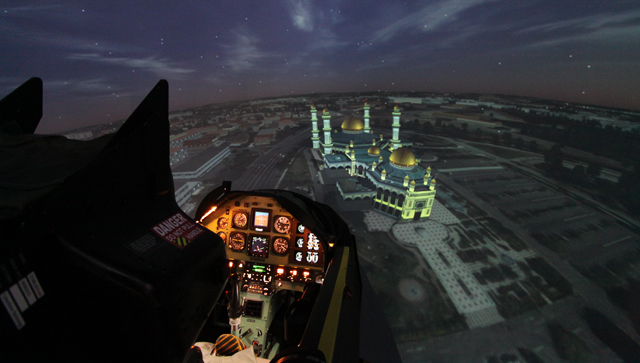A total of 74% of the close to 2,000 simulators in the defence sector are made by five manufacturers. L-3 Link Simulation & Training, a division of L-3 Communications, leads the market with a 24% share of active simulators, according to Flightglobal’s latest Military Simulator Census.
Boeing follows with a 16% share, while Canada-based CAE – the leading manufacturer in the civil market – is featured in third place with a share of 13% of devices. FSI and Thales follow with market shares of 11% and 10%, respectively, while the remaining 25% of the market is made up of other manufacturers.
Boeing types are the leading simulated aircraft, with 23% of the market, followed by Lockheed Martin and Beechcraft, with shares of 18% and 9% respectively. Helicopter manufacturers Sikorsky and Bell follow with shares of 5% each, while the remaining share of manufacturers account for 40%.
In terms of aircraft types, there are more than 200 Lockheed Martin F-16 simulators – 11% of the market – with simulators for the Beechcraft T-6 Texan II training aircraft being the next-most in use. The special mission Boeing P-8A Poseidon and the combat F/A-18 Hornet and F-15 Eagle all have a 4% market share. Most of the transport/tanker simulators are for the Lockheed Martin C-130 Hercules and C-130J Super Hercules. The majority of the simulated helicopter types are Boeing AH-64 Apache and Sikorsky SH-60 Seahawks, which have shares of 8% and 7%, respectively.

CAE
Combat aircraft simulators account for 34% of the market, while helicopter simulators total 31%. Training aircraft, special mission and transports/tankers account for 14%, 12% and 8%, respectively. UAV simulators currently represent only 1% of the share of military simulators.
The USA is where 62% of the world’s aircraft military simulators are based, with more than 1,200 devices. The US Air Force alone operates 569 devices – a market share of 46% of the simulators within the USA, and a share of 29% of the world’s military simulators. The US Navy, Army and Marine Corps have a share of 26%, 22% and 5% respectively in the USA. The remaining 1% are managed by other operators.
France accounts for a share of 4% of the world’s simulators, while the UK and Germany have 3% each. Canada has a share of 2%, while the balance of 26% of simulators is located in other countries.
Flight training devices (FTD) account for 12% of all military simulators, followed by full flight simulators (FFS) with 11%. Operational flight trainers (OFT) and full mission simulators (FMS) both have a share of 10% each, while weapon systems trainers (WST) account for 5%.
Source: Flight International























